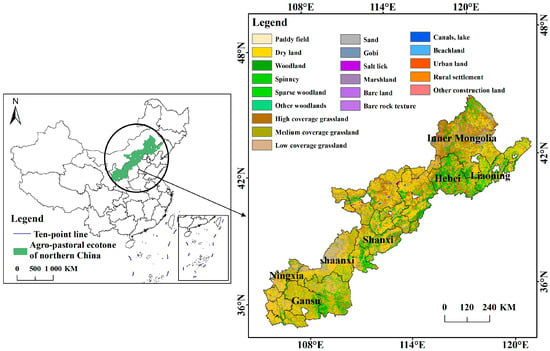1. Introduction
Cultivated land is an important part of land resources. It is not only the material basis for human survival and development, but also the cornerstone of ensuring social stability and national food security [
1,
2,
3]. Cultivated land use efficiency refers to the utilization level of cultivated land, labor and capital, directly reflecting the input and distribution of cultivated land production factors in agricultural production [
4,
5]. The agro-pastoral ecotone in northern China is mainly a transition zone formed of two types of land, namely cultivated land and grassland. It is a typical ecologically fragile area [
6,
7], mainly including regions such as Inner Mongolia, Liaoning, Hebei, Shanxi, Shaanxi, Gansu, and Ningxia, and it is the second ecological barrier in the central and eastern regions of China [
8]. It is also the key implementation area for major national ecological construction projects, such as returning farmland to forest and returning grazing land to grassland [
9,
10]. In recent years, due to the unreasonable economic activities of humans, the fertility of cultivated land in this area has declined, the phenomenon of land abandonment has surged [
11], and the efficiency of cultivated land utilization is low. Meanwhile, excessive grazing and the reclamation of grasslands in pastoral areas have led to a serious imbalance in the agro-pastoral structure, seriously endangering national food security [
12].
Regional population shrinkage is a long-term process that can significantly affect the agriculture, ecology, and environmental quality of a region. A reduction in population can restore the ecological environment within a region, especially with a significant increase in the biomass within the region [
13]. Bruno et al. [
14] utilized a linear mixed-effects model to analyze the impact of population decline in the northwestern region of Spain on the local ecosystem. The results showed that population decline in rural areas was conducive to soil conservation, food production, and water regulation. Zhang et al. [
15] analyzed the relationship between population shrinkage and the ecological environment in the Karst desert area of China. The results showed that population shrinkage and population migration alleviated land pressure in the desert area. Guo et al. [
16] indicated that rural population shrinkage in China has had a positive effect on changes in water and soil resources. However, China is still in a stage of rapid urbanization. Due to differences in the economic development levels of different regions, large-scale population movements have made the phenomenon of population shrinkage within regions more prominent [
17]. According to the relevant data of the Sixth National Population Census and the Seventh National Population Census, more than 50% of the counties in China have witnessed population decline to varying degrees, and among them, the proportion of population shrinkage in parts of counties and county-level cities is nearly 70%. Against this backdrop, studying spatio-temporal evolution and its influencing factors on cultivated land use efficiency in the farming–pastoral ecotone in northern China can provide decision-making references for ensuring national food security, promoting the coordinated development between cultivated land use and the environment, and comprehensively facilitating rural revitalization.
In 1990, Vlek [
18] first paid attention to the efficiency of cultivated land utilization and published the first paper in this field regarding the issue of improving the efficiency of fertilizer use in cultivated land in African regions. Currently, the research on the efficiency of cultivated land utilization mainly includes the following three aspects. From the perspective of research scale, research mainly starts from the micro-, meso- and macro-scales to explore the spatio-temporal evolution characteristics of and distribution differences in the efficiency of cultivated land utilization at the national, provincial, city, and county levels, in addition to other scales. For example, Yang et al. [
19] explored the efficiency of cultivated land utilization in China based on the concept of total factor input efficiency. Sun et al. [
20] analyzed the efficiency of cultivated land utilization in Shandong Province through the Data Envelopment Analysis method (DEA). Ji et al. [
5] calculated the efficiency of cultivated land utilization in the Nanyang Basin using the DEA-GWR index model. From the perspective of research content, relevant studies mainly focus on evaluation index systems, spatio-temporal distribution, influencing factors, and other aspects of the efficiency of cultivated land utilization. For example, Liu et al. [
21] established an evaluation index system for the efficiency of cultivated land utilization considering the two aspects of input and output. Xie et al. [
22] analyzed the spatio-temporal differentiation and influencing factors of the efficiency of cultivated land utilization in the Poyang Lake Ecological Economic Zone at the county level. Becker [
23] and Ndiaye [
24] measured the effects of crop mix and cropland fallow on cultivated land use efficiency. Willians [
25] mainly analyzed the relationship between arable land irrigation, pesticide application, fertilizer application, and arable land use efficiency. From the perspective of research methods, scholars generally start from the concept of cultivated land use efficiency and believe that there is a close relationship between the input factors and outputs of cultivated land. Among them, the Data Envelopment Analysis model (DEA) and the stochastic frontier analysis model (SFA) are widely used [
26,
27]. The former is calculated by the linear programming method and has the advantage of not needing to establish a function. It is a non-parametric model. The latter is a parametric method. Taking into account factors such as random error terms, it can effectively avoid the result deviations that occur in the evaluation of the DEA model [
28]. In the research on the influencing factors of cultivated land use efficiency, commonly used calculation methods include the Grey Relational Analysis method [
29], the Geographically Weighted Regression model (GWR) [
30], the Economic Index [
31], the Tobit model [
32], and so on. Among them, the Tobit model conducts regression analysis on variables based on the maximum likelihood method and can make calculations relatively accurately [
33]. From a review of the literature, we found that, on the one hand, current research mainly focuses on evaluating cultivated land use efficiency at the national, provincial, city, and county levels. There is a lack of research based on specific regions, especially the agro-pastoral ecotone in northern China. On the other hand, there is a lack of research on cultivated land use efficiency at the regional scale from specific perspectives, such as against the background of population shrinkage, which leads to insufficient policy supply.
In view of this, this paper takes the agro-pastoral ecotone in northern China as its research area, selects 145 key districts and counties, and adopts the population shrinkage measurement model to calculate the population change trends in the agro–pastoral ecotone from 2000 to 2020. The spatio-temporal changes in cultivated land use efficiency in the research area across the years 2000, 2005, 2010, 2015, and 2020 are analyzed using the stochastic frontier production function. Based on the “human–land” perspective, a total of 10 relevant indicators are selected to measure the influencing factors of cultivated land use efficiency. This can provide a reference for decision-making in the context of formulating cultivated land use policies, promoting regional sustainable development, and comprehensively contributing to rural revitalization in the agro-pastoral ecotone.
4. Discussion
This paper analyzed the temporal and spatial evolution of population shrinkage and cultivated land use efficiency in the agro-pastoral ecotone in northern China. Research indicates that the rural population in the agro-pastoral ecotone in northern China continuously declined during the research period [
38]. Cultivated land use efficiency showed an upward trend during the research period. This was mainly due to the fact that with the development of the social economy, the investment of agricultural capital in the utilization of cultivated land, such as agricultural machinery, increased year by year, which consequently led to an annual increase in cultivated land use efficiency. This research conclusion is similar to the results of previous studies [
3,
39]. Cultivated land is a semi-artificial and semi-natural composite system, and its utilization level reflects the interactive relationships between society, economy, and nature [
40].
In this paper, relevant indicators were selected from the perspective of human–land relationships to calculate the influencing factors of cultivated land use efficiency. The results show that increases in the multiple cropping index and cultivated land area among the land factors could significantly improve cultivated land use efficiency. Given the scarcity of cultivated land resources, under the goal of maximizing the utilization benefits of cultivated land, increasing the multiple cropping index of cultivated land has become a crucial path to enhance the utilization intensity of cultivated land. This is quite similar to the research of Ji [
5]. Among the population factors, increases in the proportion of rural population and average years of education can improve cultivated land use efficiency. That is to say, increases in the quantity and quality of the rural labor force could significantly improve cultivated land use efficiency. It has been found in previous studies that simply emphasizing increases in rural cultivated land area without a corresponding labor force and technological knowledge is bound to bring the dilemma of extensive cultivation with low yields to rural areas [
41].
This research still has some deficiencies. When analyzing the influencing factors of cultivated land use efficiency, only relevant indicators of population and land factors were selected for analysis, and factors such as terrain and disasters were not considered in the index system. Further research is still needed in subsequent studies to provide a strong reference basis and decision-making support for the sustainable utilization of cultivated land resources in the agro-pastoral ecotone in northern China for the guarantee of national food security.


